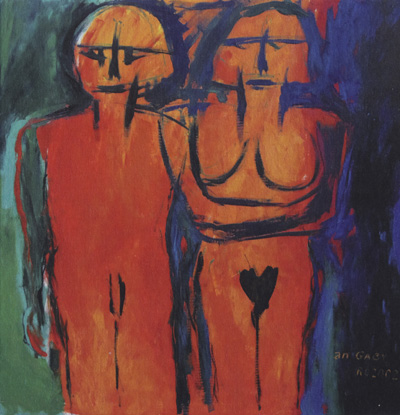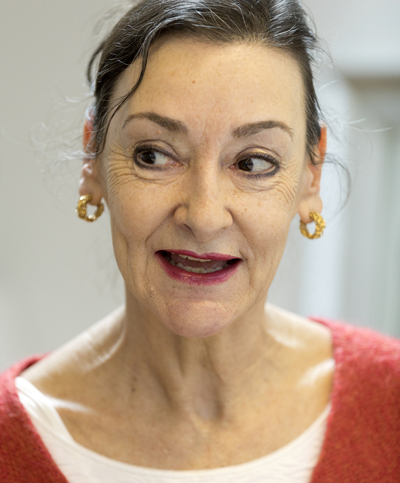A tuft of myrrh between the breasts
Freiburg, Jan 08, 2019
It's just a handful of romantic verses from times gone by. Nevertheless, over thousands of years they have inspired writers again and again: The “Song of Songs” is attributed to King Solomon in the Old Testament- one who knew his way around love. After all, he is said to have enchanted a thousand women. Why did the Song of Songs become a treasure trove of love literature? Gabrielle Oberhänsli-Widmer, professor of Jewish Studies in Freiburg, has written a book about it. In an interview with Rimma Gerenstein, she explains what novels, poems and religious writings reveal about different Jewish worlds.

Silence in paradise: The Swiss artist Rainer Oberhänsli-Widmer shows the ultimate lovers Adam and Eve as two people who don't have much to say to each other. Source: Rainer Oberhänsli-Widmer
Professor Oberhänsli-Widmer, do you remember the first time you read the Song of Songs?
Gabrielle Oberhänsli-Widmer: Oh yes, I remember it well. My boyfriend had borrowed it from the library and brought it to me. He had no idea what it was, and I, too, was completely naïve and didn't know that it was a canonical text. We were both blown away. I think that's how it goes for everyone who reads it. It’s an archaic experience - especially when you're young and in love.
While reading the text, I was amazed at the verses I came across: “My friend is like a tuft of myrrh hanging between my breasts,” it says, for example, or: “I took off my dress, how shall I put it on again?”
I know what you're alluding to. Are you surprised that such an erotic text is contained in the Bible?
Well, it is rather surprising.
Not really. The beauty of love, including physical love, was never denied in Judaism, and the biblical authors were not at all inhibited at the time of the creation of the Song of Songs. The fact that later there were such rigid rules to order sexual life has more to do with the demarcation in exile, with the protection of one’s own community. Morality is less important.

Another pool of identities: Gabrielle Oberhänsli-Widmer appreciates the breadth of Jewish love literature that spans more than 2,000 years and is written in countless languages. Photo: Jürgen Gocke
Did Jewish love literature begin with the Song of Songs?
Yes and no. It is, so to speak, the ideological starting point, but not the historical one. Biblical Israel is also based on pre-Biblical foundations. For me as a scholar, it is important to extend the historical line backwards. Then it becomes clear that the Song of Songs also draws on other texts and feeds itself on ancient Oriental and Egyptian love songs. We all continue to write; nobody starts from scratch. The Song of Songs is decisive for all European literature, a kind of love thesaurus, one could say. And it also runs like a golden thread through the texts I have examined.
Can you name an example?
The verse "Lay me like a seal on your arm, for love is as strong as death" appears again and again in different novels and poems from different eras. Originally it was meant as a lifelong relationship with a partner, as a very exclusive relationship, which someone can perhaps also understand in the negative sense. In the later reception Jewish thinkers have extended this verse to God, although it is only mentioned at one point in the entire Song of Songs. The writer Leah Goldberg, who wrote much about the horrors of the Shoa, takes up the motif in a literary love letter. There the rejecting lover Emanuel - literally translated: “God is with us” - and a figure of God merge. Her poem can be read as a clear farewell to God's love.
Was a loving God no longer conceivable after the Shoa?
Not for Goldberg, but even more for some others. This is also the special attraction of love literature, at least the good one: it is a mirror of their respective worlds. Using lovers, the authors outline not only the psyche and character of an individual, but also the thought structures, ideologies and mentalities of an epoch. They take up politics, history and culture and sometimes even have prophetic qualities. In “Love for Zion,” for example, Abraham Mapu, the father of the modern Hebrew novel, tells of the movement of Zionism - long before Theodor Herzl founded it as a national movement.

King Solomon in the Old Testament is considered the author of the Song of Songs. In Giovanni Demin’s painting he can be seen with the Queen of Sheeba. Photo: Art Renewal Center/Wikimedia Commons
What do the texts reveal about modern-day life and love in Israel?
I am thinking here of the novel All the Rivers by Dorit Rabynian, which caused a real sensation in Israel. It is a love story between an Israeli and a Palestinian - it ends in a fiasco. What is particularly striking is that the two can only be together outside Israel, for example in New York. In Israel and Palestine, respectively, they barely live 20 kilometers apart, but in Israel they are not allowed to live together, let alone marry. The Palestinian then rents a house and begins to cultivate the garden - like a paradise garden. He does this knowing that his Israeli lover will never live there with him. The novel is, of course, a fantasy. But you can ask yourself the question: If it doesn't work for a couple of lovers, how difficult is it for two groups or states? It is a tragic, but realistic assessment.
What do you think other love literatures can learn from the Jewish literary tradition?
It is not my intention to indoctrinate people. But I find the incredible breadth of Jewish love literature fascinating. It spans more than 2,000 years, is written in pious and atheistic voices, in Greek, Hebrew, Yiddish, German and many other languages. Many who are not familiar with Judaism think above all of Orthodoxy and of a narrow, oppressive life. Literature offers a wide pool of identities and shows people who repeatedly get involved with other cultures and forge something of their own, a mixed form, out of them.
Before you started to deal with love, you wrote a book about evil in Jewish literature.
Yes, and I was astonished myself: the two poles are not so far apart. In fact, they are always interwoven. Think of a divorce - nothing worse than that. Nowhere is evil so devastating as from a deep, intimate relationship. This also applies to many ideologies that have actually grown out of good intentions, but then still fall into dangerous waters. In the end one realizes that love as well as evil are only shades of grey.

To read more
Oberhänsli-Widmer, Gabrielle: „Lege mich wie ein Siegel an deinen Arm!“ Jüdische Lebenswelten im Spiegel ihrer Liebesliteratur. Stuttgart 2018.
Source: Kohlhammer

